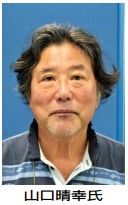Potential World Heritage Site Iriomote faces the risk of increased pollution and ecosystem destruction as more and more trash washes ashore

Professor Haruyuki Yamaguchi
October 15, 2017 Ryukyu Shimpo
By Chie Tome
Many years of large amounts of trash washing in from the ocean and accumulating in the mangrove swamps of Iriomote Island in Taketomi, a potential World Heritage Site, was having a clear effect on the mangrove and the surrounding environment.
This was made clear in a recent survey conducted by National Defense Academy Professor Emeritus Haruyuki Yamaguchi, who chairs the Okinawa Committee to Promote Policies to Prevent Coastal Pollution.
From things such as nets and ropes becoming entangled in the mangrove roots, and materials such as plastic and Styrofoam, which decompose and release hazardous substances, there is a fear that the mangrove ecosystem may be destroyed.
Professor Yamaguchi warned that not only were the mangrove swamps home to the precious Iriomote cat, a protected species, but also, “it is being looked at as a [potential] World Heritage Site, so a viable strategy is an urgent need.”
In order to get a grasp on the reality of trash washing ashore on Iriomote Island, Prof. Yamaguchi conducted a total of 32 surveys of three mangrove swamps, two at the estuaries of the Nakama and Yutsun rivers, and one on the western bank of the Hinai River estuary at Funaura. A total of 98,502 pieces of trash were collected.
The collected garbage was sorted into categories, and the preponderance of plastic such as PET bottles and containers was prominent.
At the time of the first survey in 2004, plastic comprised of 46.9% of the trash collected, which by 2017 is had increased 1.7 times, to 81.5%.
For the unique clumps of brace roots and respiratory roots of mangrove clusters, waste pushed in from the sea is a natural enemy.
If ropes or nets become entangled in the roots, there is no way for them to untangle on their own, damaging their ability to grow.
The northern coast of the island, which includes the Yutsun estuary that faces the most serious pollution, also serves as the habitat for the Iriomote cat.
With this in mind, there is an increased risk of hazardous chemicals that come from the decomposition of waste will contaminate the organisms which make up the food chain that supports the rare, protected cat.
Prof. Yamaguchi indicated that the mangrove roots play an important role, stating, “They act as a protective barrier for the enormous ecosystem by blocking sand and polluted water from the land, and is home for much of the food chain that supports the diverse ecosystem.
” Additionally, he emphasized that in order to sustain one of the world’s rarest natural environments, developing a system to patrol and assess the situation as well as quickly collect and dispose of waste was an urgent issue.
In recent years, due to a worsening of overseas trash from countries such as Korea and China, particularly on isolated islands, Okinawa has been stepping up efforts to combat such waste with measures such as forming committees of specialists.
(English translation by T&CT and Sam Grieb)
Previous Article:Ginoza Village to receive compensation more than four years after 2013 US military helicopter crash
Next Article:French actor gives a talk on the similarities between Okinawan and French cultures
[Similar Articles]
- Okinawa’s distant islands face a grave situation as hazardous waste washing ashore from overseas threatens island ecosystems
- Postbox drifts to Iriomote from tsunami-hit Miyagi town
- Assistant Professor Shitara captures photograph of Iriomote cat kitten on Iriomote Island
- “It’s scary. But, I wouldn’t ask anyone to change places with me,” Trash collection specialists proud of their work
- World’s largest sea cucumber found in Iriomote
 Webcam(Kokusai Street)
Webcam(Kokusai Street)


